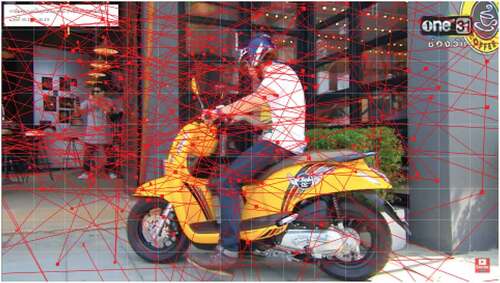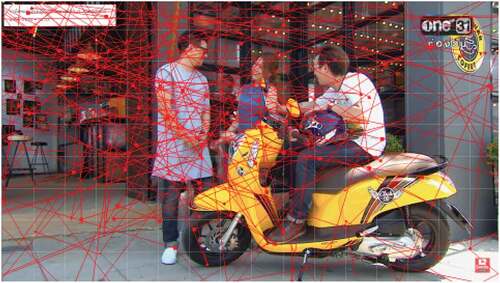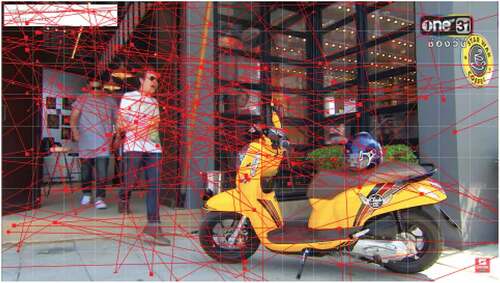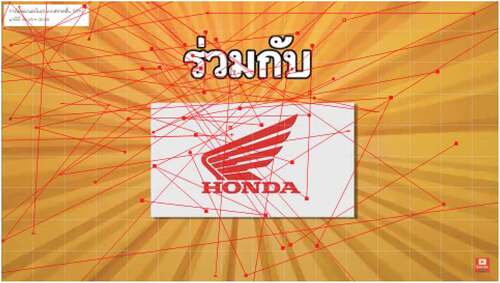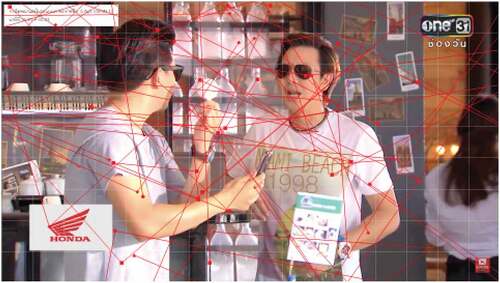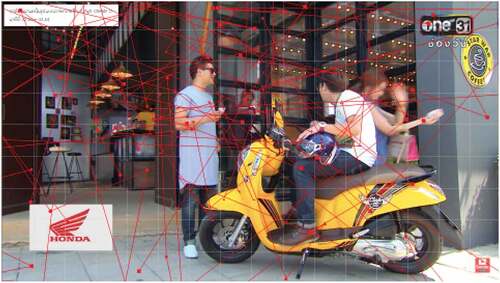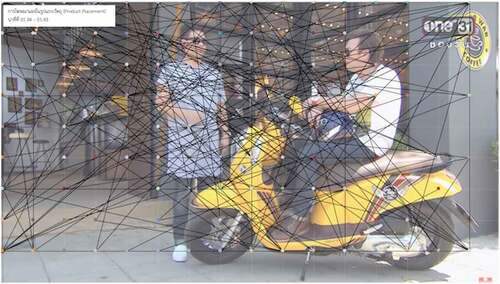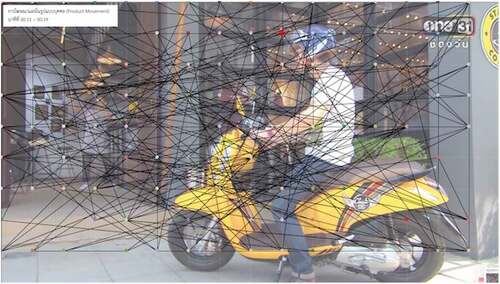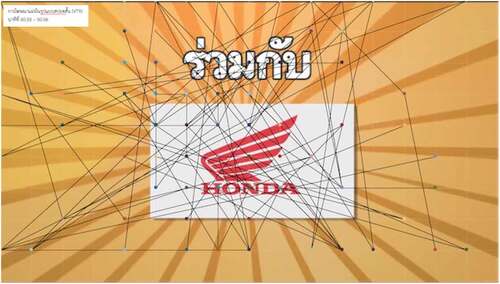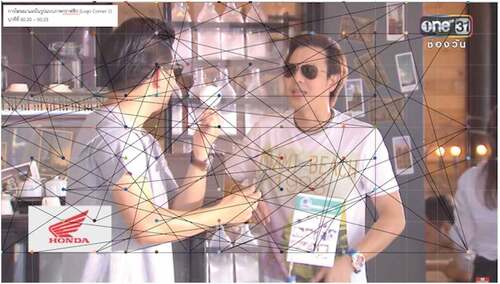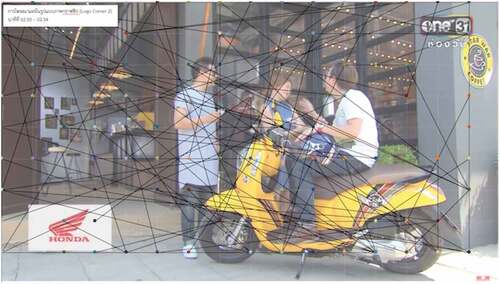Abstract
Since 1982, when one of the most successful product placements appeared in the movie ET, marketers have continued adopting this strategy in various media channels. Among those, research studies indicated that product placements in situation comedies (Sitcoms) are the most effective. This study aims to examine five forms of product placement: (1) product movement, (2) plot integration, (3) product tie-in, (4) sponsorship, and (5) graphics, which are the most effective, in terms of brand recognition and brand recall. The 3.18-minute sitcom with motorcycle placement was shown to a total of 65 participants; daily motorcycle riders and office workers. An eye tracking device was used while participants watched the sitcom. Following this, in-depth interviews were conducted with each participant. The results showed that product movement was the most effective form leading to brand recognition in lower-level education consumers, whereas plot integration is the most effective form leading to brand recognition in higher education consumers. In both groups, graphics were the least effective form leading to brand recognition. Furthermore, none of the five forms successfully led to brand recall. The key implication of this study showed that applying different forms of product placement for the different consumer education levels was the way forward. Plot integration may not always be the most effective for product placement as it is not believed, dependent on the group of consumers and media type. Plot integration in sitcom should be used with the awareness that it can irritate consumers and ultimately lead consumers to brand rejection.
1. Introduction
Product placement; an advertising strategy where the non-obtrusive promotion of products through appearances in media, is not new. The first time product placement appeared was in 1895 by the Lumière film Europe (Fossen, Citation2021). Since it first appeared, product placement has gradually increased. However, the tipping point of product placement was when it appeared in the film ET in 1982 (Jurberg, Citation2020). It suddenly made a little known brand, Reese’s Pieces candies increase in popularity by 65% (Furlan, Citation2015). Thenceforward, marketers regarded product placement strategy as the future, particularly for new media advertising (Eagle & Dahl, Citation2018). Product placement nowadays is much more useful in an era of the content-driven ecosystem (Lai & Liu, Citation2020).
Moreover, there are three key rationales that made product placement more popular than traditional advertising. First is product placement providing more entertainment (Neale & Corkindale, Citation2022). The more entertaining the advertising, the more the positive feeling over brand from the perspective of consumers (Gangadharbatla & Daugherty, Citation2013a). When consumers have enjoyed the film they receive messages differently as compared to traditional advertising (Karisik, Citation2014; Sharma & Bumb, Citation2022). Thus, the conveyance of messages from product placement leads to positive comprehension (R.K. Srivastava, Citation2016) as well as builds positive relationships with consumers (Sharma & Bumb, Citation2022).
Second, product placement offers affective persuasion (Lai & Liu, Citation2020) which creates less feeling of irritation to consumers. Irritation leads to a negative attitude toward advertising and consequentially the feeling of dislike towards a product (Eshra & Beshir, Citation2019).
Third, product placement conforms to today’s consumer behaviour. Nowadays, approximately 94% of consumers skip advertising (Ducey, Citation2022). The is a key challenge for twenty-first-century marketers. By its nature, product placement is integrated within the story context. It delivers a transformational message rather than an informational thus ensuring that consumers are exposed and engaged with the messaging (Meyer et al., Citation2016). Therefore, product placement is applied as a key to reaching into the mind of the consumer (Laban et al., Citation2020).
When using product placement as a marketing communication strategy, there are a variety of psychological processes that occur when consumers are exposed to it. The marketer’s intent is to achieve its effect by producing a cognitive, effective, and behavioural response from the targeted consumers (Kaur et al., Citation2021).
The cognitive effect typically refers to the consumer’s product/brand recall after exposure to commercial messages. The more the consumer is exposed to the product placement, the more the increase in the explicit memory of the brand thus there more opportunity for increase in the brand recall (Nordin & Baharom, Citation2018).
The effectiveness of the exposure to the product placement is measured through the development of the positive consumer’s attitude towards the brand. The brand attitude is an assessment which reflects the holistic picture of the brand (Boerman et al., Citation2021). Generally, the brand attitude could be either positive or negative after the consumer is exposed to the advertising. A positive attitude will result in a crucial stimulus in the purchasing behaviour of the consumer.
The behavioural effect is the extent to which consumers are persuaded to buy the advertised product (Becker et al., Citation2019). However, previous studies have failed to find consistency in confirmation of the relationship between exposure to product placement and behavioural response. For example, Hudson and Elliott (Citation2013) found no relationship between product placement and purchasing intention. Whereas Jung and Childs (Citation2020) and Kaur et al. (Citation2021) found the opposite.
Most studies in the past also attempted to measure the effectiveness of product placement through brand recall, brand recognition, and purchasing intention. Some used experiments and surveys (Wang & Chen, Citation2019) while some others adopted only surveys (Laban et al., Citation2020) and some others only adopted in-depth interviews (Perwitasari & Paramita, Citation2020). Typically, consumers were asked to mention brands that were presented in the advertising after they had been exposed to a movie (R. K. Srivastava, Citation2018).
Generally, the assessment methods that were found in both industrial and academic studies used cognitive and effective measures (Gangadharbatla & Daugherty, Citation2013b). Although the cognitive method is essential in helping marketers understand the mind of the consumer, the use of self-reporting methods either qualitative, in-depth interview, focus groups or quantitative questionnaires, have reported some limitations.
It is questionable whether the recall and recognition answers the consumers give are from the advertising they watch or is the accumulated experience of the consumers towards the brand. The answers given by consumers may have been affected by a sense of familiarity whereas they are unaware of where this familiarity comes from.
Therefore, this study attempts to first synergize the cognitive method using the in-depth interview which is beneficial for stimulating subconscious opinions or recall (Roller & Lavrakas, Citation2015) obtaining granularity and insightful information (Deterding & Waters, Citation2021) by incorporating eye tracking to help enrich the effective measurement of the product placement on brand recall and recognition.
While trying to understand the effect of product placement on recall and recognition are crucial, understanding the effect of different types of placement is also important (Lai & Liu, Citation2020; Yang & Roskos-Ewoldsen, Citation2007). Marketers use product placement in marketing communications in order to raise brand awareness, brand affinity and to encourage prospective purchasers. Therefore, it is crucial to explore how to effectively impose product placement in commercial advertising (Davtyan et al., Citation2020).
Furthermore, the popularity of product placement leads to an increased variety of the types of product placement currently in use. In comparison with previously when only two types, either visual or verbal product placements were examined.
Second, to comprehend and update the knowledge of today’s product placement, this study unlike the previous studies which set up in the format of experimental research. This study applied a normal condition of how consumer daily watch the sitcom; attempts to explore what are the different types of product placement found in today’s advertising setting; then apply eye tracking to measure the effectiveness of different types and posits of product placement in a sitcom.
1. Literature review
Product placement has been used in various media, and previous studies were conducted to measure product placement effectiveness in films, game shows, sitcoms series, computer/video games, online games, sport events, radio and other physical environments such as hotel rooms and rental cars (Guo et al., Citation2019; Lai & Liu, Citation2020).
Previous studies reported that each medium has different norms in the use of product placement. Different forms are considered as variables that impact effectiveness of product placement (Lai & Liu, Citation2020).
Among those, the sitcom is regarded as the medium that most successfully uses the product placement strategy. This may be because the sitcom has some similarities with the film which can include various types of product placement but with the sitcom, consumers view it more frequently and feel greater familiarity with it in their daily life activities. However, product placement in sitcom could also lead to a negative attitude amongst consumers easily (Baig et al., Citation2019). Besides, a few previous studies focused on sitcom; though the sitcom remains popularity (Keveney, Citation2020). This is why understanding how sitcom product placement effects today consumers is interesting.
1.1. Product placement and its types
Focusing more on product placement in films, movies and sitcoms, there are two main types of product placement based on dimension in the context of the story: Non prominent and Prominent.
In the first type of product placement, in sitcom, this has been termed as non-prominent (Zluhan et al., Citation2021); subtle placement (Ma, Citation2020); look and feel (Dens et al., Citation2018) and implicit product placement (Eagle & Dahl, Citation2018) is product and brand appear in the form of a logo and the brand colour mostly shown as background. No brand name is mentioned. There is no interaction between brand or product with any of the characters, so there is less connection to brand attitude and brand recall (Dens et al., Citation2018).
The second type is prominent product placement. In this second type, product and brand appear visually and verbally. Previous studies divided the prominent product placement into two types (a) Integrated explicit product placement and (b) Non-integrated explicit product placement according to how the brand and product interacted with a people.
(a) The integrated explicit product placement or interactive placement (Dens et al., Citation2018) is the most highly interactive between the product and the featured or main characters. This refers to the physical interaction with a product by a character which can be a mentioned product, or one consumed, and used by characters. The form of this placement is namely as a plot integration/connection (Sharma & Bumb, Citation2022), product experience (Akhan & Özdemir, Citation2021), character product interaction: CPI (Naderer et al., Citation2018). Due to the highly interactive and prominent visibility, this type of placement is highly stimulating to brand recall (Dens et al., Citation2018; b) Non-integrated explicit product placement refers to a product display, with active person-product interaction. In this form, the product is clearly visible in the scene. Researchers named this form of product placement as product tie-in, product display (Kembuan et al., Citation2021), or props (Dens et al., Citation2018). There is no or low connection between product and plot therefore it is only partially simulated to brand recall.
1.2. Impacts and outcomes on customers
The different types and forms of product placement provide different impacts and outcomes after consumers were exposed to it. Naderer et al. (Citation2018) pointed out 3 crucial outcomes.
The first is attitude. Attitude toward brand and product received by consumers, from product placement can be either favourable or unfavourable, like or dislike, preferred or not preferred (Khalbous et al., Citation2013). Attitude is considered as an effective outcome of product placement (Chan, Citation2020). According to the persuasion knowledge model, consumers basically interpret the message received from advertising based on the effective persuasive quality of the piece. The development of persuasion knowledge comes from the cognitive skills and accumulated experience of the consumer by exposure to social interaction and from media like advertising (Wen et al., Citation2020). Persuasion knowledge of the consumer leads to recognition, attitude, attention toward advertising. The persuasion knowledge of consumer changes from time to time.
Second is cognition which is measured in terms of memory. R. K. Srivastava (Citation2018) reported brand recall and brand recognition are outcomes that reflected the effectiveness of product placement particularly in the case of movies. This can be explained according to the emotional conditioning theory (Matthes et al., Citation2014) that entertainment content leads to an increased persuasive message. Positive emotional response helps bring in brand memory, which then leads to brand evaluation and brand choice (Naderer et al., Citation2018). Memory refers to consumer ability to recall after exposure to the advertising. Since the objective of advertising is to sell the product, if the product placement cannot induce the consumer to remember the product, consequentially there cannot be brand recall when the purchasing decision is being made.
The brand memory is divided into four types: unawareness, recognition, recall, and top of mind (Davtyan et al., Citation2020; Tritama & Tarigan, Citation2016).
First is brand unawareness, which refers to the consumer being unable to remember anything of the brand deliver message in the advertising; even with the stimulus.
The second is brand recognition. The consumer with brand recognition needs information or stimulus to be able to memorise the brand; thus sometime brand recognition is called aided recall (Bergkvist & Taylor, Citation2022; Davtyan et al., Citation2020).
The third is brand recall. The consumer exhibiting brand recall can name the brand or product from memory; thus, it is sometime call unaided brand recall (Chan, Citation2020). The last one is top of mind. The consumer may show multiple awareness of many brands in the advertisement. Thus, when asked about which brands that have been seen in the ad., the first mentioned brand is called a top of mind brand.
To measure the effectiveness of product placement, brand recall and brand recognition are mostly used. This is because, the major objective of advertising is to persuade the consumer to purchase product or brand, Hence, without recognition and recall, it is difficult for a brand purchasing decision to be made.
Therefore, with various forms of product placement and the differences of its impact on brand recognition and brand recall. In addition, among those forms of product placement, previous studies plot integration was mostly recommended as it is highly interactive and prominent visibility. This leads to two propositions as follows:
Proposition 1: Plot integration leads to higher brand recognition as compared to other forms of product placement.
Proposition 2: Plot integration leads to higher brand recall as compared to other forms of product placement.
Third outcome is cognitive (Naderer et al., Citation2018). The ultimate goal of the advertising is to gauge what influences the consumer to choose, purchase and consume the product. However, previous studies (e.g., Yang & Roskos-Ewoldsen, Citation2007; Eagle & Dahl, Citation2018; Boerman et al., Citation2021) found product placement to have little effect on purchasing intention.
1.3. The relationship between education level and product placement
Knowing the demographic background of consumers would benefit for the brand to tailor and select appropriate product placement types in the sitcom to create a positive attitude toward the brand. One of the prominent demographic is educational level. Previous studies found that educational level resulted in brand attitude. Gómez-Donoso et al. (Citation2021), Mantha et al. (Citation2018), and Van Reijmersdal et al. (Citation2010) reported that highly educated viewers were less likely to be persuaded by product/brand placement. This is because consumers’ characteristics impact on the perception of product placement, some consumers respond more positively than others (Williams et al., Citation2011). In addition, experience and attitude toward advertising are likely to affect consumer acceptance towards product placements (Kureshi & Vandana, Citation2010).
However, it is inconsistent with results from Huitink et al. (Citation2021) found that knowledgeable consumers tend to have more positive about product placement. Accordingly, it leads to a positive effect on consumer acceptance of products. Therefore, this study attempts to explore the level of educational background on product placement in the sitcom. Thus, the 3rd proposition is proposed.
Proposition 3: Higher education consumers are less likely to be persuaded by product placement
2. Methodology
While most of the study focusing on product placement has been either experiment or quantitative research. This study employed a qualitative research method and used eye tracking as a method triangulation in order to ensure the reliability of the study. The qualitative research in product placement allows researcher to have more meaning and rich information of product placement from the perspective of consumer (Chen & Haley, Citation2014) particularly in the case of movie, sitcom and film.
In this study, the YouTube broadcast sitcom series “Ha-in-one” which has a commercial purpose as well as entertainment for the audience is used. Each episode is tailored to stealthily promote a particular product manufactured by the sponsor of that episode. This study selected the real-world setting sit-com that consist the most variety forms of product placement. Therefore, this is the major difference set up between this study and the previous studies
The selected episode in this study is sponsored by Honda motorcycle, aiming to promote the new model “Honda Scoopy i”. The episode involves three main characters, and uses two major male actors as older and younger brothers, who are sharing the idea of how to become a hipster. To become a hipster, the younger brother has bought an expensive vintage bicycle. However, he has the worry of having told his girlfriend that the bicycle cost ten time less than he actually paid. The older brother advises his younger brother that being a hipster is about being confident with your own style. He then shows his younger brother his new model Honda scoopy i motorcycle. While both of them talk about the cool, trendy, original and unique style of the scoopy i, the younger brother’s girlfriend appears with the good news that she has just sold a vintage bicycle and made a profit. The younger brother is shocked by this news as he paid a great deal more for his vintage motorcycle which means a big loss for him. So he sadly admits to his brother that he should have bought the Honda scoopy i instead of the vintage motorcycle.
This selected episode consists of five forms of product placement that are currently in use by the advertising media of today, which are
First, is sponsorship, which is usually a picture/motion picture or VTR that appears at the beginning or end of a scene.
Second, is a graphic, which is shown in the corner of the screen. Another could be presented in an out of home sequence, such as a billboard or LED in the sit com story. The graphic form is usually found at the beginning, during, or end of the sit com (Jutakul, Citation2016).
Third is product tie-in. In this form of product placement, the product is posited in a scene without any actor using and no verbal reference.
Fourth is product movement. An actor is seen using the product in a scene without verbal reference.
Fifth is plot integration. The product is used and mentioned by the actor. However, the degree of plot integration could vary, starting from a low prominence degree such as a short conversion to a moderate usage like a subplot or plot integration and finally, the high prominence degree involving the theme of the story (Jutakul, Citation2016).
Because the selected episode of the sitcom is sponsored by the motorcycle brand Honda, aiming to promote the new model “Honda Scoppi i”; a total of 65 participants in this study are from a purposive sampling. All participants are motorcycle riders in their daily life and have had experience purchasing motorcycle.
All of the participants are Thais with dark brown pupil eye. As suggested by Nyström et al. (Citation2013) and Holmqvist et al. (Citation2022), eye physiology such eye sight and pupil colour could impact the accuracy and precision of eye tracking data. Taking this point into account, to ensure the accuracy of data quality in eye tracking, research recruited only normal vision participants to join the study. Moreover, none of the females used mascara as it could influence data quality. All of participants are Thai with the same eye colour to ensure the precision of eye tracking data.
Participants were divided into two groups based on their educational level and behavioural on how they are familiar with the product used in product placement; a motorcycle.
To ensure the reliability of this study, we selected the participants who did not work in a marketing related field. Presumable they have little or limited knowledge regarding product placement. However, they all have experience of watching sitcoms, but none have experience of watching the selected series for this study, “Ha-in-one”.
In the first study, the first group of a total of 30 males aged between 27 and 35 with an average age of 33 participated. They were daily motorcycle riders as they are working as motorcycle taxi vendors with public motorcycle licenses. Their education is limited to high school; the compulsory education level.
In the second study, the second group of a total 35 participants; 28 females and 7 males aged between 22 and 52 with an average of 33. This group were office workers. Their education is bachelor degree level and above.
The procedures began with asking them to watch the 3.18 minute episode through the Adgazer eye tracking program. The program is tailored particularly for this study. The copyright of the program belongs to the Artificial Intelligence in Medicine Lab (AIM Lab), Faculty of Engineering, Mahidol University. This study obtained permission from AIM Lab.
Data collection processes were arranged at the place for participants’ convenience; a motorcycle taxi terminal for the first study and office meeting room for the second study. The place is setting for comfortable and natural for participants. For participants’ convenience, most of the interviews were conducted during their break time. With the first group, eye tracking and interview mostly conduct during 14:00–15:00 under the condition of daylight.
It should be noted that the lighting condition in the first study different from the second study whereas the data collection of eye tracking occurred with fluorescent lighting. This is considered as a limitation of the study as Feit et.al. indicated that eye tracking under different light conditions are slightly different in term of precision and accuracy of eye tracking. However, the first group indicated their preferable place to participate the study at their office; the motorcycle taxi terminal. This is considered as one of the limitations of this study.
Prior to the sitcoms being watched, all participants were requested to perform a calibration using operator controlled calibration. The researcher asked participants to verify the participant’s eyesight by asking the participant for verbal confirmation. Although all participants were informed that the research study was related to advertising without any information on product placement and types of product placement. The calibration step this may lead to the Hawthorne effect; a reaction whereby respondents alter their behaviours in response to the fact that they know they are being studied (Oswald et al., Citation2014). This is considered as one kind of limitation using eye tracking method.
The interview guide was divided into three parts. First part focused on brand recall and brand recognition. The first question began with asking participants the number of actors/actresses in the sitcom. Starting with simple question related to what participants just recently have watched is suggested as it helps stimulate the memory of participants (Walsh et al., Citation2008). Following with what are the motorcycle brand that they know (Top of mind brand), what are the brand which participants had seen in the sitcom (Brand recognition); what was the slogan of the brand, what were the key messages that the brand wants to communicate (Brand recall). The order of questions was based on McCollum-Spielman guide mentioned in the study of Dubow (Citation1995). Following the guide helps mitigate the bias of during the interview. Furthermore, participants were asked about scenes and the details of the scene in which they could recall the brand. In the case that participants could not recall the brand, a list of brand was provided to measure whether they have brand recognition.
The second part focused on examining participants’ understanding and attitude toward product placement. In this part, participants were asked whether they understood the meaning of product placement and its objectives in advertising. Furthermore, participants were asked whether they had seen product placement in the sitcom, how many forms, what forms they liked/disliked and reasons for likes/dislikes. The third part focused on participants demographic such as gender, age, and occupation.
To ensure the validity of the interview guide, a content validity index (CVI) was conducted with five marketing and adverting experts from both academics and practitioners and obtained a CVI = 0.9. Each interview took approximately 45 minutes. Prior to the interview, permission to record the conversations was requested. The interview record was transcribed to use for content analysis. In this study, researcher did not provide an interview guide in advance. This is to prevent the bias and the Hawthorne effect.
During participants watched sit com, the eye movement were continuously recorded by remote eye-tracking system (SMI iView X™ RED). Data collection through the webcams with software Adgazer and were exported by the software for offline analysis using Excel.
Participants attention were measured through the dynamic are of interest (AOI) that created by Adgazer. The dataset of several eye movement indices within AOI was exported to measure participant’s visual attention (Guo et al., Citation2018).
The first fixation duration and the fixation time were chosen to measure participants’ attention allocation to the product placement (Smink et al., Citation2017; Spielvogel et al., Citation2020; Van Reijmersdal et al., Citation2020). Due to the special characteristic of this selected sit-com, various forms of product placement occurred. Data set are collected during the time each form of product placement appeared in the time frame of 3.18-minute series: Sponsorship (0.03–0.06), product movement (0.11–0.19), Graphic 1st time appeared (0.20–0.23) and 2nd time appeared (2.6–2.64) Product tie-in (1.03–1.10), Plot integration (1.34–1.43).
In the data analysis process, the results of the eye tracking for each consumer were then used in synergy with the content analysis of each in-depth interview.
3. Results
3.1. Study 1: daily motorcycle rider
All participants were first asked how many actors that had seen in the sit-com. All 30 men provided the correct answers.
Afterwards, participants were asked whether they had knowledge of product placement. A total of 29 participants provide that correct answer that indicated that they understand the meaning of product placement. Whereas one of them admitted that he did not understand product placement however what he expressed reflects a very limited knowledge of product placement that
“… I have never heard about the word product placement before … however I think the sitcom wants to present the motorcycle to the audience. I remember see the logo of the brand “Honda” in the sitcom … Male rider, age 30
However, the majority answer was that the product placement is attempted to convince consumers to buy the product.
… In this sitcom, it is like an advertising. They want to sale a motorcycle. However, I do not feel annoying as they do not directly sales. The story of the motorcycle aligns well in the sitcom story … Male rider, age 25
Few of participants; 6 out of 30 mentioned their understanding of product placement even more specifically by giving an example of that from the sitcom. The product placement is from the brand “Honda”.
… The product placement is one kind of advertising. They want to convince audience to buy Honda. I remember see the Honda logo in the first scene and also the Honda Scoopy i motorcycle in the sitcom … Male rider, age 21
Furthermore, they were asked whether they had noticed that product placement in the sitcom they had recently watched or not. All participants admitted that they had seen the product placement.
In the second step, participants were asked to name three motorcycle brands that they know. Honda, Yamaha, and Suzuki were the top three brands consecutively with 93%, 77% and 43%. This indicated that Honda is the top of mind brand.
In the third step, to measure brand recognition, all participants were asked what was the motorcycle brand they had seen in the sitcom. All men provided the name “Honda” which was a correct answer. These conclude that all have brand recognition after seeing the product placement in the sitcom.
Afterwards, participants were asked which scenes they remembered seeing the brand logo or the product. The most mentioned product placement form is the product movement. Thirteen out of 30 participants (43%) stated that they remembered one of the male actors riding a motorcycle in the scene. This confirmed the result of eye tracking presented in Figure .
The eye tracking also showed results that participants’ eye movement followed the direction of the actor that riding the motorcycle.
The second most mentioned scene by 10 out of 30 participants (33%) indicated they remembered was the plot integration. The eye tracking results are displayed in Figure .
… I remember that the actors talking. It is a funny story. The two men talking that they should buy the Honda motorcycle rather than buying expensive bicycle … Male rider, age 27
The product tie-in is the third rank mentioned by the participants. During the interviews only 4 out of 30 participants (13%) mentioned that they remembered the brand from the product tie-in. It is from the scenes when that the motorcycle is parked in the front of the coffee shop while no message related to the Honda motorcycle is mentioned. As compared to the first two: product movement and plot integration, the eye tracking result in indicated less density on the motorcycle.
Sponsorship is a form of product placement mentioned only by 3 out of 30 participants (10%). The interview results were consistent with the eye tracking. It is interesting to note that, according to the eye tracking results, participants rarely focus on the brand name “Honda”. This may because the participants could not understand English. One of the participants revealed that
… I immediately remember the logo of Honda. I showed in the beginning … I cannot read in English but I know that it is a Honda name with the logo. This is because I am using the Honda motorcycle … I like its engine … Male rider, age 32
This is an interesting point to note the difference between study 1 and study 2 whereas in study 1, participants had lower levels of education than those in study 2. Thus, participants in study 1 focused more on the Thai alphabet as addressed in the yellow box in Figure .
The graphic is the product placement form that none of the participants mentioned in the interview. The result of the eye tracking in conforms the in-depth interviews. It is interesting to note that in the sitcom. This form of product placement; graphic was showed twice as compared to other forms of product placements. However, the Honda graphic logo got less attention from participants.
This study showed interesting result that the scene that group 1 participants indicated as the most recognized scene is consistent with the results from the eye tracking. As well, the results supported the proposition 1a that different forms of product placement lead to different levels of brand recognition.
In the fourth step, participants were asked which forms of product placement that they like the most and which forms of product placement that they feel most annoying. The ranking results are presented in Table .
Table 1. A ranking comparison of the study 1 results between eye tracking and interview methods
The results clearly indicated that graphics are the most annoying forms of product placement. Therefore, it leads to the least brand recognition and the least view according to the eye tracking. Additionally, sponsorship is considered as not preferable and does not effectively lead to brand recognition.
In term of the most likeable form of product placement. Product tie-in received the most popular vote whereas it was ranked as the third viewed and recognized. Product movement; the most viewed and recognized scene is the second most likable form. However, it is very interesting to find that plot integration is claimed as an annoying form of product placement even though it is the second most powerful result leading to the brand recognition from eye tracking data.
In the fifth step, to measure brand recall, all participants were asked to describe what they remembered in relevance to either the product slogan: “Honda New Scoopy i-Live Original” or product key attributes: “Honda New Scoopy i- Cool Chic Trendy with your own unique style”. The results from interviews revealed that none of them provided the correct answer for the slogan or product key attribute. Only 9 participants correctly remembered part of the slogan and the attribute. For example, “Honda New Scoopy i”, “Scoopy i”, “Cool Chic”, “Honda-unique style”, “Live Original”.
This means that product placement in this sitcom failed to create brand recall. Brand recall is counted only with the correct answer of slogan or product key attributes according to Van Reijmersdal et al. (Citation2010).
In the final step, the participants were asked about their purchasing intention after watching the sitcom. The majority of participants (21 out of 30 participants; 70%) stated that from exposure to product placement in the sitcom induced them to buy Honda if they were to buy a new motorcycle due to the reasons of chic, cool and unique design following with a powerful engine.
… It the sitcom it presented the new design … I like the new design and the bright color … If I will have a chance to buy the new motorcycle I will buy the Honda … Male rider, age 33
… The Honda New Scoopy i looks very trendy … I like its design … An engine is also good … its engine save fuel … Male rider, age 34
Whereas the rest; 9 out of 30 participants (30%) said that product placement could not induce them to buy Honda. The main reason is that they have their own favorite brand; Yamaha. Either that or they mentioned the negative experience from using Honda.
… I like the new design that I saw in sitcom … Its color also nice … Although the design is very nice and beautiful but the engine is not that durable … Male rider, age 32
3.1.1. “ … From my experience using Honda, the engine in not that good. It is not durable … ” Male raider, age 34
3.2. Study 2: office worker
Similar to study 1, study 2ʹs opening question was on the numbers of actors seen in the sitcom. All 35 participants gave the right answers. For example,
… Product placement is the inclusion of a branded product in media such as in YouTube or in game show … in movie, we see actors using or eating some sponsored product … umm … football sponsor also another example of product placement … Female office worker, age 23
Next, participants’ knowledge on product placement were examined. A total of 30 participants showed their correct understanding of product placement while 2 participants admitted that they knew nothing about product placement and gave no answer. Moreover, 3 participants explained their understanding of product placement but their answers were wrong. For example,
… Product placement is a normal advertising that we usually seen. It is a various products presenting in the advertising … Female office worker, age 35
Besides, participants were asked whether they had seen the product placement in the experiment sitcom, a total of 32 participants said there was product placement in the sitcom they recently watched. On the contrary, 2 participants stated that there was not a product placement in the sitcom. As well, one stated that she was not so sure.
In the second step, participants were asked to name three motorcycle brands that they knew. Honda, Yamaha, and Suzuki were the top three brands in their minds with 94%, 77%, and 32%. This is a similar pattern to study 1. Honda occupies the top of the mind brand.
In the third step, to measure the brand recognition, all participants were asked what were the motorcycle brands they had seen in the sitcom. The 33 participants’ answer was Honda and 9 among those 33 even mentioned the model name, Honda Scoopy i. Only 2 out of 35 participants gave wrong answer. This reflects that the majority of participants had brand recognition after exposure to product placement.
After that, participants were asked which scenes they remembered seeing the brand logo or the product. A total of 14 participants (41%) expressed that they remembered the scene that actors had a conversation about buying motorcycle. Here are some examples which participants expressed about the plot integration such as
… I firmly remember the scene that actors chit chat … They keep on repeating the message of collecting money to buy the motorcycle … Keep on saying embedded the scene in my memory … Male office worker age, 23
The result of eye tracking on the plot integration is presented in Figure .
In addition, the second most mentioned scene by 7 out of 35 participants (20%) indicated that they noticed the product placement when the actor was riding a Honda motorcycle in the scene.
… At the moment the actor rides the motorcycle in, I immediately notice that it is the product placement advertising. It is easy for me to remember … This is because I own the same model … Male office worker, age 36
The result of eye tracking on the product movement is presented in Figure .
Furthermore, 6 out of 35 participants (16%) indicated that they noticed the sponsor’s logo of Honda at the beginning of the episode. The result of eye tracking on the spornsorship is presented in .
In study 2, product tie-in and graphic are equally mentioned by 4 out of 35 participants (11%). The results of eye tracking on the graphic logo (1st time) and the graphic logo (2nd time) are presented in consecutively.
In the fourth step, participants were asked which forms of product placement that they liked the most and which forms of product placement that they felt was most annoying. The ranking results are presented in Table .
Table 2. A ranking comparison of the study 2 results between eye tracking and interview methods
The results from the in-depth interviews on brand recognition confirmed the eye tracking results. However as compared to study 1, the ranking is slightly different. The first rank in study 1 is reported as the second rank in study 2 and vice versa. The graphic remains the least effective forms of product placement.
The most liked form of product placement goes in the same direction with the eye tracking and brand recognition through the in-depth interviews. Similar to study 1, plot integration is claimed as the most annoying form of product placement even though it leads to the first rank leading consumers to brand recognition. There are some example opinions why 17 out of 35 participants (49%) felt the irritation of plot integration such as
… I dislike the plot integration the most … The more the conversion on the product the more the annoying the feeling … Female office worker, age 27
Another negative comment sample is
… When I enjoy the story of the sitcom, the conversion that attempts to advertise the motorcycle make me feel bad. It seems like I was cheating … Female office worker, age 33
The second most annoying rank is graphic. A total of 7 participants indicated that graphic made them feel irritated. For example,
… The worst form of product placement in this sitcom is the graphic logo … It makes me feel dizzy … Female office worker, age 24
The sponsorship is ranked the third annoyed by 5 out of 35 participants (14%). And the rest of 5 participants commented that they did not feel that any product placements appeared in the sitcom was annoying by giving the similar reason that they had enjoyed the sitcom and product placement as the new normal of advertising. This differs from the participants in the study 1.
Brand recall was measured in the fifth step. All participants were asked to describe what they remembered in relevance to either the product slogan or product key attributes. All 35 participants shared that they could not remember the product slogan at all. Some participant shared commonalities that they focused and enjoyed the sitcom story.
… I enjoy the sitcom … It is funny … I remember key words such as cool, good looking, Trendy … But not the slogan of the product … Female office worker age, 52
Among all participants, 8 of them remembered the word Honda Scoopy i. In addition, 2 participants said they remembered the product attributes such as vintage and low price motorcycle. Unfortunately, these two attributes are not mentioned at all in the sitcom.
In the final step, the participants were asked about their purchasing intention after watching the sitcom. The majority of participants (24 out of 35; 69%) stated that the product placement from sitcom had no impact on their willingness to buy Honda. The reasons varied, for example, they already had their favourite brand, they did not like the style, etc. However, it is important to note that a few of participants (3 out of 24) revealed that they have negative attitude toward brand because of the product placement hence they did not intent to buy Honda. Their opinions are as following
… I feel that the product placement interrupts me from enjoying the sitcom … hence the more I see the product placement, the more the dislike feeling so I will not buy Honda … Female office worker, age 23
… From the sitcom, it could not catch my interest. I feel annoying … .as compare between product placement and direct adverting … I would rather prefer the hard sales form … Female office worker, age 32
… When I want to buy a motorcycle, I will place the decision making criteria on product functions efficiency … Product placement in the sitcom provides too less information … if possible they should provide more product information to audiences … Female office worker, age 33
In summary, in both study 1 and study 2, results from in depth interview align with the method triangulation with eye tracking. However, the forms of product placement that participants correctly answered that make then recognize the brand may not be the forms of product placement that they most likable.
4. Discussions and practical recommendations
Using a self-reporting method like interviews and eye tracking is very helpful. Thus employing in-depth interviews together with eye tracking is recommended as it leads to synergy. The study found that product placement in selected sitcoms leads to brand recognition for both high and low educational level consumers. The Honda brand is the top recognized brand. This may be because Honda has dominated as a market leader of the motorcycle in Thailand for more than 33 years.
Eye tracking helps confirm that the results of the in depth interview on brand recall and brand recognition. The forms of product placement that participants stated that it made them recognize the Honda brand as well as gave details correctly are the same. However, all participants in both studies could not recall the brand from the sitcom product placement thus the proposition 2: Plot integration leads to higher brand recall as compared to other forms of product placement is rejected.
The most identified form of product placement in the study 1 is product movement, with the rationale that it best induces brand recognition. Also, consumers like it, as it creates the least annoying feeling. Plot integration creates the highest attention in study 2. Thus, the study found inconsistent results from the two studies, but plot integration is still considered as one of the top two forms that increases brand recognition.
Therefore, this partially confirmed proposition 1: that Plot integration leads to higher brand recognition as compared to other forms of product placement.
In comparison with previous studies (e.g., Russell & Stern, Citation2013;; Alruwaily et al., Citation2020; Glaser & Reisinger, Citation2022) reported on plot integration effectively leads to brand recognition, this study found the different results. This may be because previous researches were designed as an experimental design whereas a single form of product placement was tested. Unlike this study that selected sit com was broadcasted in a real-world setting. This may be the weakness of the lab setting study that single message or one stimuli were tasted if the researchers did not design well enough to overcome its weakness (Beaufort, Citation2019).
Moreover, this study would recommend using plot integration with caution, because without smooth integration and too much repetition by the actors, this will lead to consumer irritation, and as a consequence could lead to a negative attitude towards the brand.
Furthermore, avoiding the provision of too much information, but rather emphasize only the key product attributes. This is the best strategy for the creation of brand recall. Product information content is considered important in product placement. To reduce the intrusiveness is to provide the value information to consumer. When consumer obtains important or interesting information from advertising, they feel less likely to be irrupted or interrupted (Chen et al., Citation2022; Edwards et al., Citation2002; Niu et al., Citation2021).
Product tie-in is suggested though it does not create a high degree of brand recall when compared to product movement and plot integration, but consumers like it as it creates less annoyance. In order to use product tie-in more effectively, this study would like to suggest one practical implication as a tactic emerging from the eye tracking data, that the closer the product tie-in is, is the better way to get consumer attention.
Sponsorship is found as the difference between the two groups of consumers. The higher level education consumers focus more on brand name which is written in English and vice versa for the lower education group. Thus, it is recommended that for the brand targeting the lower level of education, brand logo is more important. Localization of the brand name using local language may attract greater attention.
The least effective and least preferable is graphic because graphics lead to annoyance. Eye tracking confirmed that, because consumers perceive graphics as annoying and the consumers do not pay attention looking only at the graphic so this lead to the lowest degree of brand recall. Although the advertising agency may repeat the graphic for a short period of time like twice in the sitcom while other forms appears only once, both graphics appeared to receive a low agree of attention.
Regarding brand recall, product placement in this selected sitcom did not successfully make consumers in both groups memorize the slogan and brand key attributes. This is because the measurement was set up so that consumers ought to report all correct. However, it is interesting to note that in this case although the consumers in study 1 may have a lower level of education compared to study 2; provided more partially correct answers. This may be because they are daily riders and are therefore more familiar with the product.
Product placement cannot persuade higher level education consumers in study 2 in the intention to purchase because this group tends to compare product information between brands before making a decision to purchase. On the other hand, product placement does induce the purchasing intention of the lower level education group in study 1. However, this study further found that with consumers who have had a negative experience with a brand, product placement has no impact on purchasing intention.
Herewith, the study accepted proposition 3 that higher education consumers are less likely to be persuaded by brand placement.
5. Conclusions
The in-depth interview is rich in terms of understanding the attitude and affection of consumers but eye tracking scientifically confirms the validity of the results. Using eye tracking synergised with the self-report method, this study highlighted different results when compared to previous studies that used only the self-reporting method. Using various effective product placement forms such as product movement, product tie-in, plot integration and sponsorship lead to consumer brand recognition. However, eye tracking plot integration may not always be the most effective product placement as it is believed. This is dependent on the group of consumers and media types. Plot integration in sitcoms should be used with the awareness that it can annoy consumers and ultimately cause consumers to turn to brand rejection.
6. Limitations and suggestions for future research
This study has potential limitations. First, the eye tracking technology only recorded eye movement. Therefore, data retrieved from eye tracking should be used in conjunction with additional data collection methods in order to obtain accurate interpretation of the recording. This study therefore applied in-depth interviews together with eye tracking, to examine brand recall, brand recognition and purchasing intention, with data drawn from 30 participants in study 1 and 35 participants in study 2. A greater number of participants for future studies would hopefully provide more affirmative results. The second limitation is the product deployed in the sitcom; the motorcycle is considered a high involvement product therefore results may differ in the case of a low involvement product. Hence, it will be interesting for future studies to examine product placement in the deployment of a low involvement product.
Disclosure statement
No potential conflict of interest was reported by the authors.
Additional information
Funding
Notes on contributors
Jittima Kongmanon
Jittima Kongmanon is a master degree student at the College of Management, Mahidol university.
Phallapa Petison
Phallapa Petison is a full-time faculty and the program chair of the business management program at the College of Management, Mahidol University. Her research interests include strategic marketing management, consumer behaviour, and qualitative research method.
References
- Akhan, C. E., & Özdemir, E. (2021). The effect of in-game product placement on attitude towards in-game purchasing intention: A study on young consumers. Erciyes Üniversitesi İktisadi ve İdari Bilimler Fakültesi Dergisi, (61), 385–22 10.18070/erciyesiibd.990855.
- Alruwaily, A., Mangold, C., Greene, T., Arshonsky, J., Cassidy, O., Pomeranz, J. L., & Bragg, M. (2020). Child social media influencers and unhealthy food product placement. Pediatrics, 146(5) 1–10). https://doi.org/10.1542/peds.2019-4057
- Baig, M., Butt, A. F., & Khattak, M. A. (2019). Hilarious sitcoms as marketing platform to enhance product appeal through star power: A study to investigate the effectiveness of QMobile advertisement when introduced in situational comedy Bulbulay. GMJACS, 9(2), 18 https://www.gmjacs.bahria.edu.pk/index.php/ojs/article/view/104
- Beaufort, M. (2019). How candy placements in films influence children’s selection behaviour in real-life shopping scenarios–an Austrian experimental field study. Journal of Children and Media, 13(1), 53–72. https://doi.org/10.1080/17482798.2018.1547776
- Becker, M., Wiegand, N., & Reinartz, W. J. (2019). Does it pay to be real? Understanding authenticity in TV advertising. Journal of Marketing, 83(1), 24–50. https://doi.org/10.1177/0022242918815880
- Bergkvist, L., & Taylor, C. R. (2022). Reviving and improving brand awareness as a construct in advertising research. Journal of Advertising 51 (3) , 1–14. https://doi.org/10.1080/00913367.2022.2077268
- Boerman, S. C., Tessitore, T., & Müller, C. M. (2021). Long-term effects of brand placement disclosure on persuasion knowledge and brand responses. International Journal of Advertising, 40(1), 26–48. https://doi.org/10.1080/02650487.2020.1775036
- Chan, F. F. Y. (2020). Prior disclosure of product placement: The more explicit the disclosure, the better the brand recall and brand attitude. Journal of Business Research, 120 November 2020 , 31–41. https://doi.org/10.1016/j.jbusres.2020.07.028
- Chen, H., Chan-Olmsted, S., Kim, J., & Sanabria, I. M. (2022). Consumers’ perception on artificial intelligence applications in marketing communication. Qualitative Market Research: An International Journal, 25(1), 125–142. https://doi.org/10.1108/QMR-03-2021-0040
- Chen, H., & Haley, E. (2014). Product placement in social games: Consumer experiences in China. Journal of Advertising, 43(3), 286–295. https://doi.org/10.1080/00913367.2013.858086
- Davtyan, D., Cunningham, I., & Tashchian, A. (2020). Effectiveness of brand placements in music videos on viewers’ brand memory, brand attitude and behavioral intentions. European Journal of Marketing, 5(22), 420–443 https://doi.org/10.1108/EJM-08-2019-0670.
- Dens, N., De Pelsmacker, P., & Verhellen, Y. (2018). Better together? Harnessing the power of brand placement through program sponsorship messages. Journal of Business Research, 83 2018 , 151–159. https://doi.org/10.1016/j.jbusres.2017.10.036
- Deterding, N. M., & Waters, M. C. (2021). Flexible coding of in-depth interviews: A twenty-first-century approach. Sociological Methods & Research, 50(2), 708–739. https://doi.org/10.1177/0049124118799377
- Dubow, J. S. (1995). Advertising recognition and recall by age-including teens. Journal of Advertising Research, 35 (5) , 55–61 https://go.gale.com/ps/i.do?p=AONE&u=googlescholar&id=GALE|A17802911&v=2.1&it=r&sid=AONE&asid=2618fdfc.
- Ducey, S. (2022). The ‘Skip Ad’ button: 4 strategies to keep consumers watching. https://digilant.com/the-skip-ad-button-4-strategies-to-keep-consumers-watching/ The digilant [Accessed August 20, 2022]
- Eagle, L., & Dahl, S. (2018). Product placement in old and new media: Examining the evidence for concern. Journal of Business Ethics, 147(3), 605–618. https://doi.org/10.1007/s10551-015-2955-z
- Edwards, S. M., Li, H., & Lee, J. H. (2002). Forced exposure and psychological reactance: Antecedents and consequences of the perceived intrusiveness of pop-up ad. Journal of Advertising, 31(3), 83–95. https://doi.org/10.1080/00913367.2002.10673678
- Eshra, N., & Beshir, N. (2019). Effect of consumer attitude towards SMS advertising and demographic features on Egyptian consumers buying decision. Journal of Marketing Management, 7 (2) , 70–76 doi:10.15640/jmm.v7n2a8.
- Feit, A. M., Williams, S., Toledo, A., Paradiso, A., Kulkarni, H., Kane, S., & Morris, M. R. (2017). Toward everyday gaze input: Accuracy and precision of eye tracking and implications for design. In Proceedings of the 2017 Chi conference on human factors in computing systems. 1118–1130.
- Fossen, B. L. (2021). The science of product placements – And why some work better than others. https://theconversation.com/the-science-of-product-placements-and-why-some-work-better-than-others-165435 The Conversation UK [Accessed August 20, 2022]
- Furlan, A. (2015). Product placement in Japan: A focus on the animation industry. [ master’s thesis]. []: Ca’ Foscari University of Venice
- Gangadharbatla, H., & Daugherty, T. “A comparison of consumers’ responses to traditional advertising and product placement strategies: Implications for advertisers” in Proceedings of the Conference American Academy of Advertising, ed. W. D. Pullman, (Chicago: American Academy of Advertising, 2013a).
- Gangadharbatla, H., & Daugherty, T. (2013b). Advertising versus product placements: How consumers assess the value of each. Journal of Advertising Research, 34 (1) , 21–38 doi:10.1080/10641734.2013.754706.
- Glaser, M., & Reisinger, H. (2022). Don’t lose your product in story translation: How product–story link in narrative advertisements increases persuasion. Journal of Advertising, 51(2), 188–205. https://doi.org/10.1080/00913367.2021.1973623
- Gómez-Donoso, C., Sacks, G., Vanderlee, L., Hammond, D., White, C. M., Nieto, C., … Cameron, A. J. (2021). Public support for healthy supermarket initiatives focused on product placement: A multi-country cross-sectional analysis of the 2018 International Food Policy Study. International Journal of Behavioral Nutrition and Physical Activity, 18(1), 1–12. https://doi.org/10.1186/s12966-021-01149-0
- Guo, F., Ye, G., Duffy, V. G., Li, M., & Ding, Y. (2018). Applying eye tracking and electroencephalography to evaluate the effects of placement disclosures on brand responses. Journal of Consumer Behaviour, 17(6), 519–531. https://doi.org/10.1002/cb.1736
- Guo, F., Ye, G., Hudders, L., Lv, W., Li, M., & Duffy, V. G. (2019). Product placement in mass media: A review and bibliometric analysis. Journal of Advertising, 48(2), 215–231. https://doi.org/10.1080/00913367.2019.1567409
- Holmqvist, K., Örbom, S. L., Hooge, I. T., Niehorster, D. C., Alexander, R. G., Andersson, R., Benjamins, J. S., Blignaut, P., Brouwer, A. M., Chuang, L. L., Dalrymple, K. A., & Hessels, R. S. (2022). Eye tracking: Empirical foundations for a minimal reporting guideline. Behavior Research Methods https://doi.org/10.3758/s13428-021-01762-8.
- Hudson, S., & Elliott, C. (2013). Measuring the impact of product placement on children using digital brand integration. Journal of Food Products Marketing, 19(3), 176. https://doi.org/10.1080/10454446.2013.724370
- Huitink, M., Poelman, M. P., Seidell, J. C., & Dijkstra, S. C. (2021). The healthy supermarket coach: Effects of a nutrition peer-education intervention in Dutch supermarkets involving adolescents with a lower education level. Health Education & Behavior, 48(2), 150–159. https://doi.org/10.1177/1090198120957953
- Jung, E., & Childs, M. (2020). Destination as product placement: An advertising strategy to impact beliefs and behavioral intentions. Journal of International Consumer Marketing, 32(3), 178–193. https://doi.org/10.1080/08961530.2019.1662355
- Jurberg, A. (2020). 7 Product placements we still talk about years later. https://bettermarketing.pub/7-product-placements-we-still-talk-about-years-later-6144ef43c1fc Better Marketing Publisher [Access 20 August 2022]
- Jutakul, P. (2016). Product placement strategies in Sitcom. Journal of Communicating Management, 2 (2) May – August 2016 (in Thai), 110–122 http://www.gscm.nida.ac.th/public-action/eJournal/Vol.2-59/7.pdf.
- Karisik, V. J. (2014). 20 years of research on product placement in movie, television and video game media. Journal of Economic and Socialogy Studies, 4 (2) , 253–283 http://dx.doi.org/10.14706/JECOSS114210.
- Kaur, R., Sharma, R. K., & Bakshi, A. (2021). Antecedents and consequences of consumers’ attitudes toward product placements: Evidence from India. International Journal of Emerging Markets, 2021((9)). https://doi.org/10.1108/IJOEM-09-2020-1087
- Kembuan, K. F., Lapian, S. L. V. J., & Wangke, S. J. (2021). The influence of Samsung product placement in Korea drama “Cash landing on you” on brand memory. Jurnal EMBA: Jurnal Riset Ekonomi, Manajemen, Bisnis Dan Akuntansi, 9(4), 95–104 https://doi.org/10.35794/emba.v9i4.36141.
- Keveney, B. (2020). Why we can’t expect more big sitcoms that bond us in a post-“Modern Family” world. https://www.usatoday.com/story/entertainment/tv/2020/02/27/is-modern-family-last-big-sitcom-hit/4876315002/ NewsGrooveUK [Accessed August 20, 2022]
- Khalbous, S., Vianelli, D., Domanski, T., Dianoux, C., & Maazoul, M. (2013). Attitudes toward product placement: A cross-cultural analysis in Tunisia, France, Italy, and Poland. International Journal of Marketing Studies, 5(2) 138–153 https://hal.archives-ouvertes.fr/hal-01369730/document).
- Kureshi, S., & Vandana, S. (2010). Review of placement literature: Conceptual and managerial implications. Journal of Marketing Management, 9 Feb–May 2010 , 23–39 https://www.iupindia.in/510/IJMM_Review_of_Placement_Literature_23.html.
- Laban, G., Zeidler, C., & Brussee, E. (2020). Binge-watching (Netflix) product placement: A content analysis on different product placements in Netflix originals vs. non-Netflix originals, and drama vs. comedy shows. https://pure.uva.nl/ws/files/29759234/Laban_ECREA2018_TVS03.pdf University of Amsterdam [Accessed August 20, 2022]
- Lai, I. K., & Liu, Y. (2020). The effects of content likeability, content credibility, and social media engagement on users’ acceptance of product placement in mobile social networks. Journal of Theoretical and Applied Electronic Commerce Research, 15(3), 1–19 https://www.scielo.cl/pdf/jtaer/v15n3/0718-1876-jtaer-15-03-00102.pdf.
- Ma, M. H. K. (2020). Impact of product placement strategies on brand reception-Literature review. Humanitas University Research paper, 69.
- Mantha, M. S. S., Srivastava, R. K., & Phalle, M. (2018). A study on effectiveness of product placement in diverse media. Journal of Industrial and Engineering, 11 (7) , 1–9 doi:10.26488/IEJ.11.7.1136.
- Matthes, J., Wonneberger, A., & Schmuck, D. (2014). Consumers’ green involvement and the persuasive effects of emotional versus functional ads. Journal of Business Research, 67(9), 1885–1893. https://doi.org/10.1016/j.jbusres.2013.11.054
- Meyer, J., Song, R., & Ha, K. (2016). The effect of product placements on the evaluation of movies. European Journal of Marketing, 50(3/4), 530–549. https://doi.org/10.1108/EJM-12-2014-0758
- Naderer, B., Matthes, J., & Zeller, P. (2018). Placing snacks in children’s movies: Cognitive, evaluative, and conative effects of product placements with character product interaction. International Journal of Advertising, 37(6), 852–870. https://doi.org/10.1080/02650487.2017.1348034
- Neale, M., & Corkindale, D. (2022). Make product placement work for you: Get less exposure. Business Horizons, 65(2), 149–157. https://doi.org/10.1016/j.bushor.2021.02.034
- Niu, X., Wang, X., & Liu, Z. (2021). When I feel invaded, I will avoid it: The effect of advertising invasiveness on consumers’ avoidance of social media advertising. Journal of Retailing and Consumer Services, 58 January 2021 , 102320. https://doi.org/10.1016/j.jretconser.2020.102320
- Nordin, M. A. S. M., & Baharom, S. N. (2018). A study on awareness of product placement in Malaysian movies. Journal of Ideology, 3 (2) , 159–175 doi:10.24191/idealogy.v3i2.80.
- Nyström, M., Andersson, R., Holmqvist, K., & Van De Weijer, J. (2013). The influence of calibration method and eye physiology on eye tracking data quality. Behavior Research Methods, 45(1), 272–288. https://doi.org/10.3758/s13428-012-0247-4
- Oswald, D., Sherratt, F., & Smith, S. (2014). Handling the Hawthorne effect: The challenges surrounding a participant observer. Review of Social Studies, 1(1), 53–73. https://doi.org/10.21586/ross0000004
- Perwitasari, D. A., & Paramita, E. L. (2020). Product placement on Korean drama as an effective tool for brand positioning. Case study: Laneige. Muara Ilmu Ekonomi dan Bisnis. Business and Economics Review, 4 (1) , 145–155 doi:10.24912/jmieb.v4i1.7717 .
- Roller, M. R., & Lavrakas, P. J. (2015). Applied qualitative research design: A total quality framework approach. The Guilford Press.
- Russell, C. A., & Stern, B. B. (2013). Consumers, characters, and products: A balance model of sitcom product placement effects. Journal of Advertising, 35(1), 7–21. https://doi.org/10.2753/JOA0091-3367350101
- Sharma, S., & Bumb, A. (2022). Product placement in entertainment industry: A systematic review. Quarterly Review of Film and Video, 39(1), 103–119. https://doi.org/10.1080/10509208.2020.1811606
- Smink, A. R., van Reijmersdal, E. A., & Boerman, S. C. (2017). Effects of brand placement disclosures: An eye tracking study into the effects of disclosures and the moderating role of brand familiarity. Journal of Advertising Research, VIII, 85–96.
- Spielvogel, I., Naderer, B., & Matthes, J. (2020). Again and again: Exploring the influence of disclosure repetition on children’s cognitive processing of product placement. International Journal of Advertising, 39(5), 611–630. https://doi.org/10.1080/02650487.2019.1648984
- Srivastava, R. K. (2016). Promoting brands through product placement in successful and unsuccessful films in emerging markets. Journal of Promotion Management, 22(3), 281–300. https://doi.org/10.1080/10496491.2015.1095831
- Srivastava, R. K. (2018). Do low involved brands have better consumer perception due to product placement in emerging markets?. Journal of Marketing Communications, 24(4), 360–374. https://doi.org/10.1080/13527266.2017.1414705
- Tritama, H. B., & Tarigan, R. E. (2016). The effect of social media to the brand awareness of a product of a company. Communication and Information Technology Journal, 10(1), 9–14. https://doi.org/10.21512/commit.v10i1.1667
- van Reijmersdal, E. A., Neijens, P. C., & Smit, E. G. (2010). How media factors affect audience responses to brand placement. International Journal of Advertising, 29(2), 279–302. https://doi.org/10.2501/S0265048710201154
- Van Reijmersdal, E. A., Rozendaal, E., Hudders, L., Vanwesenbeeck, I., Cauberghe, V., & Van Berlo, Z. M. (2020). Effects of disclosing influencer marketing in videos: An eye tracking study among children in early adolescence. Journal of Interactive Marketing, 49(1), 94–106. https://doi.org/10.1016/j.intmar.2019.09.001
- Walsh, P., Kim, Y., & Ross, S. D. (2008). Brand recall and recognition: A comparison of television and sport video games as presentation modes. Sport Marketing Quarterly, 17(4 201–208 https://fitpublishing.com/content/brand-recall-and-recognition-comparison-television-and-sport-video-games-presentation-modes).
- Wang, Y., & Chen, H. (2019). The influence of dialogic engagement and prominence on visual product placement in virtual reality videos. Journal of Business Research, 100 July 2019 , 493–502. https://doi.org/10.1016/j.jbusres.2019.01.018
- Wen, J. T., Kim, E., Wu, L., & Dodoo, N. A. (2020). Activating persuasion knowledge in native advertising: The influence of cognitive load and disclosure language. International Journal of Advertising, 39(1), 74–93. https://doi.org/10.1080/02650487.2019.1585649
- Williams, K., Petrosky, A., Hernandez, E., & Page, R.,sJr. (2011). Product placement effectiveness: Revisited and renewed. Journal of Management and Marketing Research, 7 April 2011 , 1–14 https://www.aabri.com/manuscripts/10712.pdf.
- Yang, M., & Roskos-Ewoldsen, D. R. (2007). The effectiveness of brand placements in the movies: Levels of placements, explicit and implicit memory, and brand choice behavior. Journal of Communication, 57(3), 469–489. https://doi.org/10.1111/j.1460-2466.2007.00353.x
- Zluhan, C. L., Godinho, L. F., Petroll, M. D. L. M., & Scussel, F. B. C. (2021). When brands lead the scene: A longitudinal analysis of product placement in the transformers movies franchise. Revista Ciências Administrativas, 27(1 1–12). https://doi.org/10.5020/2318-0722.2021.27.1.9539

